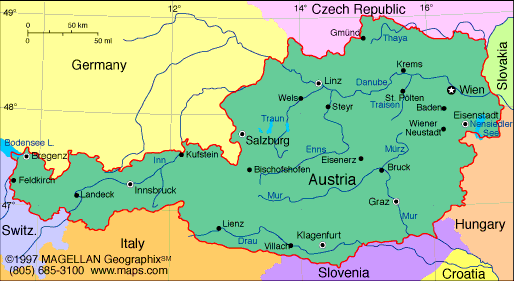Austria

Austria
Geography
Slightly smaller than Maine, Austria includes much of the mountainous territory of the eastern Alps (about 75% of the area). The country contains many snowfields, glaciers, and snowcapped peaks, the highest being the Grossglockner (12,530 ft; 3,819 m). The Danube is the principal river. Forests and woodlands cover about 40% of the land.
Government
Federal republic.
History
Settled in prehistoric times, the central European land that is now Austria was overrun in pre-Roman times by various tribes, including the Celts. After the fall of the Roman Empire, of which Austria was part, the area was invaded by Bavarians and Slavic Avars. Charlemagne conquered the area in 788 and encouraged colonization and Christianity. In 1252, Ottokar, king of Bohemia, gained possession, only to lose the territories to Rudolf of Hapsburg in 1278. Thereafter, until World War I, Austria's history was largely that of its ruling house, the Hapsburgs. Austria emerged from the Congress of Vienna in 1815 as the continent's dominant power. The Ausgleich of 1867 provided for a dual sovereignty, the empire of Austria and the kingdom of Hungary, under Franz Joseph I, who ruled until his death on Nov. 21, 1916. The Austrian-Hungarian minority rule of this immensely diverse empire, which included German, Czech, Romanian, Serbian, and many other lands, became increasingly difficult in an age of emerging nationalist movements. When Archduke Francis Ferdinand was assassinated by a Serbian nationalist in Sarajevo in 1914, World War I, as well as the destruction of the Austro-Hungarian Empire, began.
During World War I, Austria-Hungary was one of the Central powers with Germany, Bulgaria, and Turkey, and the conflict left the country in political chaos and economic ruin. Austria, shorn of Hungary, was proclaimed a republic in 1918, and the monarchy was dissolved in 1919. A parliamentary democracy was set up by the constitution of Nov. 10, 1920. To check the power of Nazis advocating union with Germany, Chancellor Engelbert Dolfuss in 1933 established a dictatorship, but he was assassinated by the Nazis on July 25, 1934. Kurt von Schuschnigg, his successor, struggled to keep Austria independent, but on March 12, 1938, German troops occupied the country, and Hitler proclaimed its Anschluss (union) with Germany, annexing it to the Third Reich.
After World War II, the U.S. and Britain declared the Austrians a “liberated” people, but the Russians prolonged the occupation. Finally Austria concluded a state treaty with the USSR and the other occupying powers and regained its independence on May 15, 1955. The second Austrian republic, established Dec. 19, 1945, on the basis of the 1920 constitution (amended in 1929), was declared by the federal Parliament to be permanently neutral.
On June 8, 1986, former UN secretary-general Kurt Waldheim was elected to the ceremonial office of president in a campaign marked by controversy over his alleged links to Nazi war crimes in Yugoslavia. Austria became a member of the European Union in 1995, but it retained its strict constitutional neutrality and forbade the stationing of foreign troops on its soil.
In Feb. 2000 the conservative People's Party formed a coalition with the far-right Freedom Party, headed by Jörg Haider. A nationalist against immigration, Haider had made several controversial remarks praising some Nazi policies, which he has since recanted. His gradual rise to power was credited to voters weary of decades of stasis under the rule of the Social Democrats. The European Union condemned Austria's new coalition, froze diplomatic contacts, and imposed sanctions, accusing Haider of being a racist, xenophobe, and Nazi-sympathizer. Given the controversy, Haider chose not to join the government, but he continued to wield influence from the sidelines.
In Sept. 2002, the coalition between the People's Party and the Freedom Party dissolved after a shake-up in the Freedom Party, instigated by Haider. In Nov. 2002, the People's Party made large gains in general elections. After failed coalition talks with other parties, the People's Party again formed a government with the Freedom Party in Feb. 2003. A government plan to overhaul the country's pension program led to widespread strikes in May and June 2003—the first national strikes in decades.
In 2004, Heinz Fischer, known as the “left conscience” of the Social Democrat Party, was elected to the largely ceremonial role of president.


<< Home